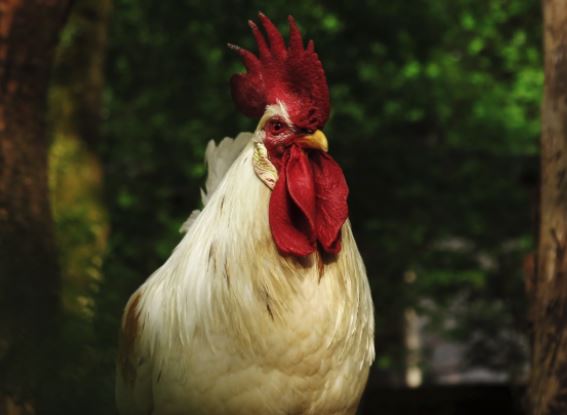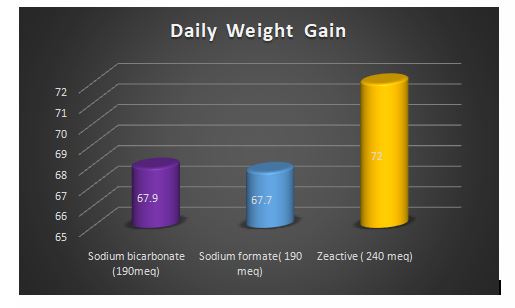
As the global demand for protein increases, so too do the demands placed on our meat-producing animals. Like top athletes that are constantly performing at the edge of their ability, these animals are asked to perform at the apex of their genetic and physiological capabilities. It is our job as nutritionists to do what we can to keep them in balance throughout their lives. In the same way that a serious athlete recognizes the importance of managing dietary electrolyte balance (dEB) so too should we see the benefits of managing the dEB of our animals. And yet, while diets are often balanced down to the energy and individual amino acid percentages, dietary electrolyte balance is seldom, if ever, automatically calculated as part of a formulation optimization result or even part of commonly used nutrient recommendations.
Electrolytes (sodium, potassium, and chloride) are compounds that dissolve into positive and negative particles in solution. The relationship between these compounds, known as the ‘dietary electrolyte balance’ (DEB), is affected by either electrolyte or its supplemental salt source. The National Research Council recommended 0.20% sodium, chloride, and 0.30% potassium for the starter phase and lower doses of sodium and chloride for the finisher phase of broilers. However, these requirements are increased under heat stress conditions, and birds perform better when increasing levels of these electrolytes are offered, maintaining a DEB of preferably 250 mEq/kg. Increased levels of these electrolytes, especially sodium, were found effective for growth but caused increased water consumption and ultimately higher litter moisture in summer. In conclusion, a combination of the electrolytes with higher levels of cations and lower level of anions is recommended. DEB is an indication of the metabolizable ions that can generate or consume acid during metabolism. As such, the very significant balance between acids and bases in the organism is closely related to the cation-anion balance. Diets with a low dEB are likely to cause metabolic acidosis, whereas alkalosis is expected with diets high in dEB. Metabolic acidosis has been implicated with reduced feed intake — the most obvious symptom that affects productivity. Dietary electrolyte balance may also affect energy, amino acid, vitamin and mineral metabolism. For example, excess dietary alkalinity (high dEB) may increase lysine oxidation and, thus, increase the requirement for lysine.
Heat stress causes excess panting leading to respiratory alkalosis. As the birds pant, they respire excessive amounts of carbon dioxide, which leads to reduced concentrations of carbonic acid and hydrogen. In response, the kidneys respond by regulating excretion and secretion of these compounds in an attempt to maintain the acid-base balance. As a consequence, the balance of monovalent ions — closely related to acid-base balance — also change: Potassium and sodium concentrations decrease, whereas that of chlorine increase. In reverse, it is hypothesized that by altering the dietary electrolyte balance during heat stress, it might be possible to minimize the negative effects of heat stress. The processes involving carbon dioxide partial pressure (PCO2), HCO-3, and pH is peculiarly effective in transporting and regulating the CO2 resulting from the metabolic processes (Filley, 1972). Because of their physiological characteristics, birds are subject to alkalosis during high temperature exposure as a result of PC02 loss during panting (Calder and Schmidt-Nielson, 1968; Frankel and Frascella, 1968). Because of the economic effects of reduced growth rates resulting from chronic heat exposure and death losses resulting from acute heat exposure, there is interest in alleviating the effects of high temperature through chemical manipulation of the blood acid-base balance. Teeter et al. (1985) reported the use of dietary ammonium chloride (as a potential blood acidifier and the use of sodium bicarbonate (NaHC03) as a source of HCO-3 in alleviating the effects of chronic heat exposure in broiler chickens. both NaHC03 and NH4Cl has dramatically changed blood pH..
The requirements of different electrolytes (sodium, potassium and chloride), dietary electrolyte balance (DEB) and salt source in broilers have considerably changed in recent times. The increasing level of sodium (Na), potassium (K) and DEB are associated with higher pH (i.e. alkalosis) while lower levels of chloride (Cl) and DEB are linked with a lower pH (i.e. acidosis). A narrow range of DEB (150–250 mEq/kg) is recommended to overcome the variations in acid base homeostasis and normal blood chemistry especially in summer conditions. The supplementation of suitable salts like NaHCO3 and KCl are proven to be beneficial to sustain viability of various biochemical processes. The cations usually alleviate whereas anions exacerbate the lysine:arginine antagonism. In most cases, the electrolytes and their balance (DEB) are considered ineffective in order to influence carcass and related traits; however, the supplementation of their respective salts under heat stress, showed contrary but potentially useful results. The role of electrolytes in combination with coccidiostats is still ambiguous; however, the level of both entities (electrolytes and coccidiostats) should be kept low and studied in detail for mutual compatibility. The inclusion level of electrolytes from various salt sources changes whenever there is change in coccidiostat and environmental condition. Keeping in mind environmental constraints, it is recommended to use the lower dosage alongside ionophores. Consequently, it is recommended to supplement electrolytes and maintaining dietary electrolyte balance (150–250 mEq/kg) is mandatory to exploit improved physiological responses of broilers for maximum growth response.
Considering the loss of electrolytes during the periods of heat stress when panting birds are experiencing respiratory alkalosis. During heat stress, the loss of carbon dioxide (CO2) through respiration and bicarbonate ions coupled with monovalent cations (particularly sodium and potassium) through urine, disturbed the acid-base balance (respiratory alkalosis). The corrections in blood acid-base balance have been achieved by electrolyte supplementation, either through drinking water or feed. These electrolytes, in different amounts and proportions, proved beneficial for broilers under different heat stress regimens. The discrepancies exist among different research workers about an appropriate DEB for heat-stressed broilers. Different environmental conditions in which broilers are reared; heat stress regimens (cyclic, acute, chronic), feeding regimens, source of electrolyte salts, combination of different electrolyte sources and the bird’s genotype itself are factors that influence the requirements of a particular electrolyte as well as their balance in the diet.
The importance of dEB for performance
Nutritionists had observed for a long time – that there is an optimum dEB. For poultry, this is at around 240 mEq.They also showed that on either side of the curve apex one could expect poorer performance as measured by weight gain, feed consumption and feed conversion ratio (FCR). The fact that as animal nutritionists we finally had a tool with which to calculate dietary electrolyte balance. In its simplest form, the dEB is the balance between Na+, K+ and Cl- in the feed and is calculated as follows:
dEB (mEq) = Na/0,023 + K/0,039 – Cl/0,035, where Na, K and Cl is in g/kg dry matter.
What is interesting is that commonly used nutrient recommendations such as breed manuals or NRC recommendations do not take dEB into account. As such, for broilers between 106 mEq and 310 mEq5-7 depending on which values you choose amongst the range of acceptable Na+, K+ anCl- values given by various nutrient guidelines8. Most notably, layer breed nutrient guides lack recommendations given for some of the macro minerals making it impossible to calculate dEB. This information is particularly disconcerting considering that these electrolytes are integrally linked with fluid and acid-base balance in the organism. As such, they are part of the most tightly controlled physiological mechanisms in the body. Mechanisms that affect everything from bone density, heart and breathing rate, thirst, to nutrient absorption in the intestine to mention a few.
What to choose to increase dEB?
The challenge for a nutritionist is to increase the dEB in the most cost efficient way possible. Many try to achieve this by increasing the salt (NaCl) content of the diet, but rapidly reach the limit of what is feasible since Na+ is tied to Cl- in the dEB calculation. It is possible to increase the dEB using potassium sources such as potassium bicarbonate. This solution is not favourable when compared to using sodium to improve dEB. Mainly due to the relatively smaller impact on dEB which means that the costs involved in achieving a similar result are inhibitive. This leaves a combination of the electrolytes with higher levels of cations and lower level of anions is recommended.as a first choice for increasing the dEB.
As is commonly known this buffering effect is caused by the addition of sodium bicarbonate to an acidic environment such as the stomach, which neutralises the acid. This in turn increases the gastric pH and releases CO2 and water. It is precisely this effect that is capitalised upon when we use sodium bicarbonate based antacids to get relief from our own heartburn or indigestion symptoms, whose instant relief is usually signalled with a satisfying eructation of CO2 – we burp. However, for our animals this mechanism has a number of negative nutritional implications. Firstly, an increase in pH negatively affects the key proteolytic enzymes. Pepsinogen requires a low gastric pH to convert to pepsin and pepsin in turn has its activity optimum at a pH 2 and ceases to function above pH 6.5. Secondly, any commercial acidifiers added to the diet will effectively be neutralised by up to 30% by sodium bicarbonate (Figure 3). So, while sodium bicarbonate provides sodium, this is either at the cost of added acidifiers, digestive performance or both.
Average daily weight gain of broilers at day 35 with sodium bicarbonate or Sodium formate Zeactive (cplVetnova ).

Conclusion
There is no doubt that optimising dEB in broilers can have significantly positive effects and give performance improvements of 4-7%. However, when balancing dEB, the choice of sodium source may affect other performance enhancers as well as total feed cost. While sodium bicarbonate has the potential to increase gastric pH and neutralise a substantial part of the gastric acid or any added feed acidifier, so combination of the electrolytes with higher levels of cations and lower level of anions is recommended.As a first choice for increasing the dEB.Optimising the dietary electrolyte balance and choosing the correct tool to achieve balance is key to achieving significant broilers performance, improvements and profitability.
By :-Dr.Yogesh Paharia
M.V.Sc (Nutrition)
















